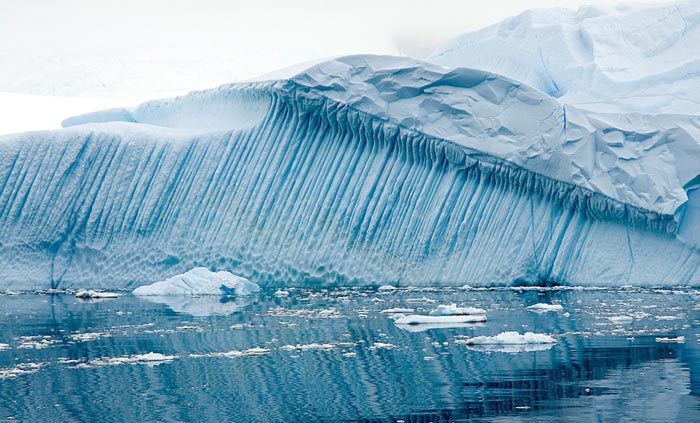
© 2008 Cliff Kolber. All Rights Reserved.
Iceberg on Gerlach Strait.
Antarctic icebergs are created from the Antarctica ice shelf and glaciers that fracture over time. Large chunks of the freshwater ice cap eventually “calve” into the sea. The beautiful carvings are created during the calving and from weather and erosion.
Nikon D300, Nikon 24-120mm f/3.5-5.6 lens at 120mm, f/9 at 1/400 sec, ISO 200, hand held from deck of ship
If you are fortunate to have visited Antarctica then you know that words and photographs cannot describe the incredible beauty, immense vastness and remote desolation of the White Continent. It is a grandiose wilderness of ice packs, glaciers, volcanoes, mountains, and wildlife that seem to go on forever. It is the coldest, windiest and driest continent in the world. It is also the largest desert in the world with just 4 inches of precipitation a year. Since there is no evaporation, snow has stacked up over years, centuries and millennia, creating the tallest continent in the world with elevations of ice up to 10,000 feet. Near the shores and in the seas are wildlife not found anywhere else in the world. It is a magical place!
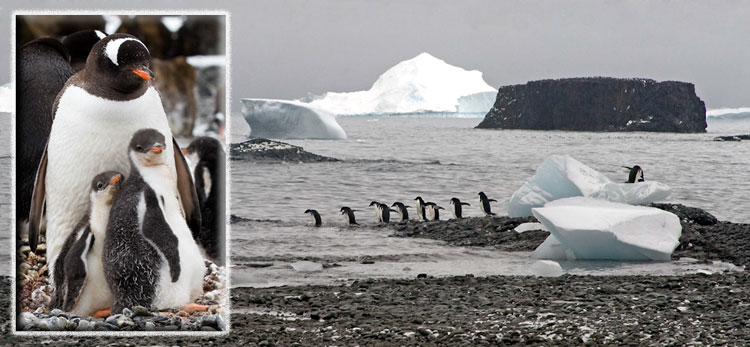
© 2008 Doris Kolber. All Rights Reserved.
Adelie Penguins heading to sea in search of food for their chicks at Brown Bluff on the Antarctic Peninsula.
Canon 30D, Canon 28-135mm f/3.5-5.6 at 135mm, f/16 at 1/200 sec, ISO 200, hand held
Insert: Gentoo Penguins make their nests from a pile of stones and both parents share the responsibility of taking care of the chicks as they grow. Brown Bluff, Antarctica
Canon 30D; Canon 100-400mm f/4.5-5.6L lens at 150mm; f/11 at 1/100 sec; ISO 200; hand held
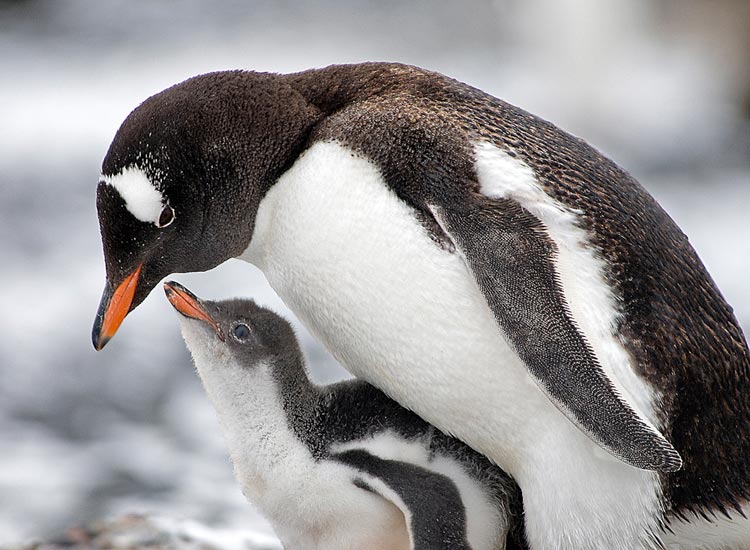
© 2008 Cliff Kolber. All Rights Reserved.
This adult Gentoo Penguin was caring for its chick at a rookery on Brown Bluff on the Antarctica Peninsula. In order to capture this shot at eye-level I sat on the ground that was covered with snow and penguin guano. This is when a poncho comes in handy to sit on.
Nikon D300, Nikon 80-400mm lens at 400mm, f/5.6 at 1/400 sec, ISO 200, hand held
A trip to Antarctica will most likely be a “once in a lifetime” trip, so you want to be prepared photographically to capture memorable images. A little bit of advance preparation and knowledge will go a long way toward a successful portfolio of images.
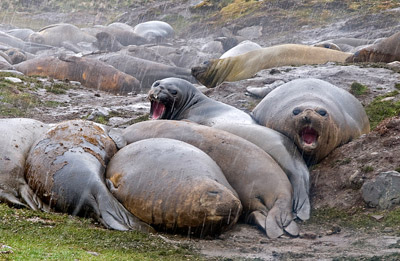
© 2008 Cliff Kolber. All rights reserved.
Elephant Seals weigh up to two tons and yet are fairly agile. These seals were huddled in a gully at the top of a ridge about a quarter mile from the ocean on St. Andrews Bay.
Nikon D300, Nikon 24-120mm f/3.5-5.6 lens at 75mm, f/11 at 1/30 sec, ISO 400, hand held
Antarctica had been on our (my wife and I) travel “bucket list” for many years and we finally made it there in 2008. We chose an expedition that catered to adventure travelers in general, rather than devoted to photographers. As such, we knew we would be transferring from ship to Zodiac to shore more than once a day and we would have limited time during each landing. Expedition ships are small, holding 100 or less passengers. If you want to land on Antarctica you need to book with one of these expedition ships since, by international agreement, only 100 people are allowed onshore per landing in Antarctica. We made sure to look only at these ships. Larger cruise line ships “sail-by” Antarctica without making any landings.
The Antarctic Peninsula is accessible to visitors only during the Antarctic spring and summer months of November through March. This is when the ice packs surrounding Antarctica have melted, temperatures are in the 20’s to 40’s and penguin chicks have hatched and are growing rapidly.
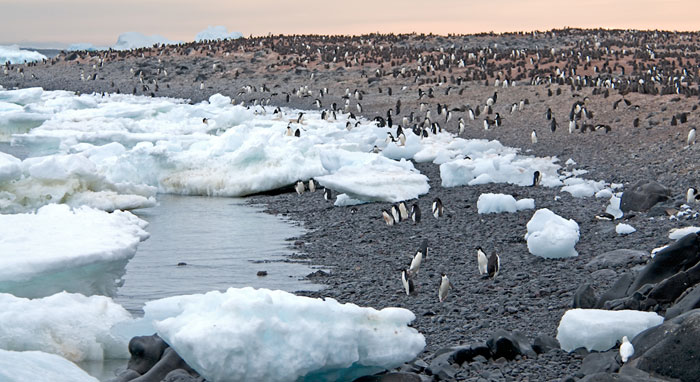
© 2008 Cliff Kolber. All Rights Reserved.
Thousands of Adelie Penguins breed on Paulet Island, which is actually a small volcano about a mile in diameter. It has a frozen lake in the crater with extinct lava covering the island. The black beach is a combination of volcanic rock and penguin guano.
Nikon D300, Nikon 80-400mm f/4.5-5.6 lens at 160mm, f/5.0 at 1/640 sec, ISO 200, hand held
Our strongest advice is to shoot everything you see. This is divergent from the normal order of photography, but Antarctica is not a normal destination. It is sometimes difficult to recognize and appreciate the beauty of this continent until after you are gone. Also, be sure to shoot from the deck of the ship. Of the 95 passengers on our ship, less than a half dozen were consistently shooting from the deck. It’s not always easy though. You might have to bear the fury of freezing wind, surf and snow. But get out on deck and shoot! The scenery and the landscapes are incredible and they change from moment to moment. And, shooting from the deck will also be your only opportunity to photograph albatrosses and petrels soaring behind and around the ship.
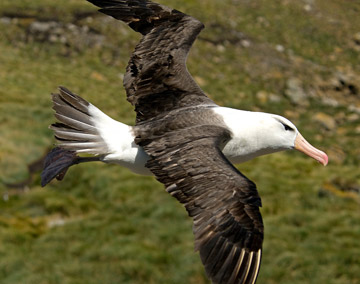
© 2008 Cliff Kolber. All rights reserved.
West Point Island: A large rookery of Black-Browed Albatrosses lies on sea cliffs high above the ocean on West Point Island in the Falkland Islands. This albatross was using a flight path directly above us to approach the rookery.
Nikon D300, Nikon 80-400mm VR f/4.5-5.6 lens at 80mm, ISO 400, f/5 at 1/6400 sec, handheld
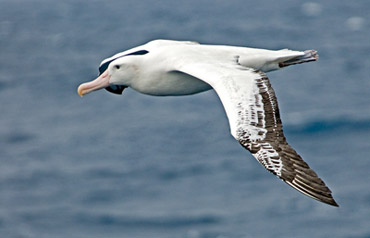
© 2008 Cliff Kolber. All rights reserved.
Wandering Albatrosses have the largest wing span of all birds in the world, almost 12’ across. These magnificent birds spend most of their life in flight, landing only to feed and breed.
Nikon D300, Nikon 80-400mm f/4.5-5.6 lens at 400mm, f/5.6 at 1/2000 sec, ISO 400, hand held from deck of ship
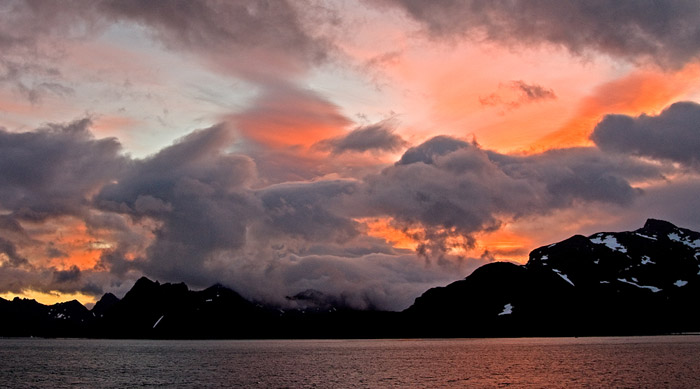
© 2008 Cliff Kolber. All Rights Reserved.
Sunrise in the Antarctica summer is a slow, lingering process, especially since the sun sets for only about an hour each night. This fiery sunrise scene lasted well into the morning on Salisbury Plain, South Georgia.
Nikon D300, Nikon 24-120mm f/3.5-5.6 lens at 24mm,
f/6.3 at 1/100 sec, ISO 200, hand held from deck of ship
The landscapes of Antarctica are stark. They can be pure white snow, pure black mountains or any other variety of tones and colors. Cameras are pre-set to expose at “mid-gray” and will turn white snow gray in the image. Most DSLR’s will adjust the exposure so that snow comes out pure white without manual compensation. But check your exposures to confirm. If you need to manually compensate, try setting the exposure compensation to +2 and check the results on the histogram. Most of the graph should be in the middle or slightly to the right (lighter). If it is, you should end up with a good exposure. If not, adjust accordingly. Always be sure that you are familiar with your camera and metering system before leaving home.
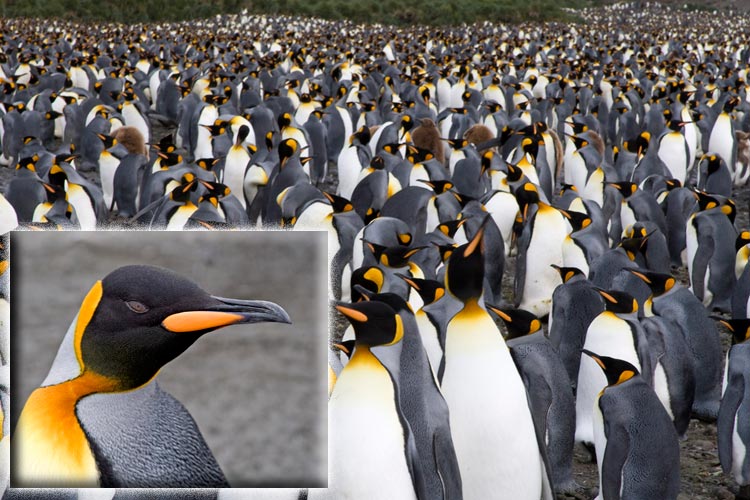
© 2008 Doris Kolber. All Rights Reserved.
King Penguins on Salisbury Plain, South Georgia. These are some of the largest penguins in the world with vibrant breeding grounds throughout Sub-Antarctica.
Canon 30D, Canon 28-135mm f/3.5-5.6 lens at 127mm, f/16 at 1/30 sec, ISO 400, hand held
Insert: King Penguin on St. Andrews Bay, South Georgia
Canon 30D, Canon 28-135mm f/3.5-5.6 lens at 135 mm, f/5.6 at 1/100 sec, ISO 400, hand held
Our ship was rocking and rolling several days in heavy storms and it was difficult to stand upright without help. The seas can be “iffy” in Antarctica and can range from glass calm to typhoon conditions. But you get only one chance in Antarctica, so wrap your arms around the deck railing for stability and shoot. Of course, be sure to protect your camera from the elements.
We sailed through extraordinary straits and channels – Bransfield Strait, Gerlach Strait, Antarctica Sound and the most famous for its scenery, Lemaire Channel. The landscape along these straits is stunning. Each day was more beautiful and spectacular than imagined. On overcast days (of which we had many) the sky flows into the mountains, while clouds and fog blend together as one. We could not tell where the sky ended and the sea began. And again, your only opportunity to capture these scenes and landscapes is from the ship, so be sure to spend your time on deck rather than in your cabin or in the lounge.
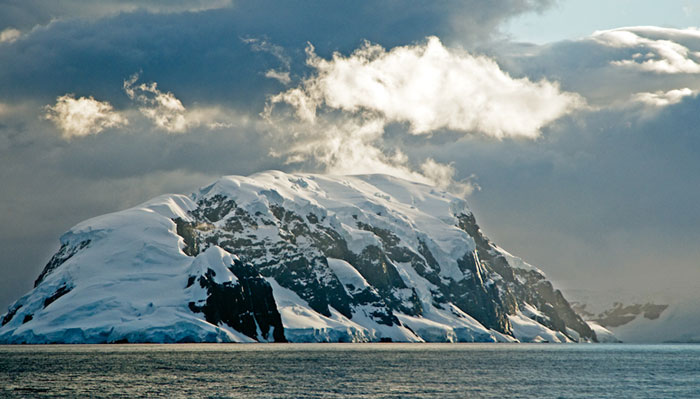
© 2008 Cliff Kolber. All Rights Reserved.
Sunset on Bransfield Strait is an amazing scene. Bransfield Strait is a body of water
that straddles the Antarctic Peninsula and South Shetland Islands and contains
some of the most incredible scenery in Antarctica.
Nikon D300, Nikon 24-120mm f/3.5-5.6 lens at 120mm,
f/5.6 at 1/1000 sec, ISO 200, hand held from deck of ship
You will be transferring from ship to zodiac to shore several times a day. Sometimes the landings will be “wet” where you swing out of the zodiac into the water and then walk a few steps to shore. Everyone wears knee-high waterproof boots so the landing is not a problem. Sometimes the landings are onto slippery or unbalanced rocks. Even though the crew assists in getting on and off the zodiacs, you want your photo gear compactly packed and protected during these forays. We packed our gear in Lowe Pro Mini-Trekkers and packed those inside rubber dry bags for the rides to and from shore. The Mini-Trekkers worked very well and kept our gear safe and compact with room left over for water and snacks, etc.
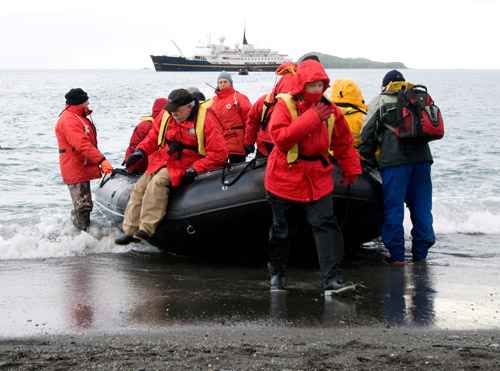
© 2008 Cliff Kolber. All rights reserved.
Salisbury Plain: Zodiac rafts are used as transport between ship and shore in Antarctica. Sometimes the landings are fairly easy like this one on the beach, and sometimes they are a little more difficult on rocks and slippery surfaces.
Nikon D300, Nikon 24-120mm f/3.5-5.6 lens at 40mm, f/11 at 1/100 sec, ISO 400, hand held
My gear consisted of: Nikon D300 body, D100 body for backup, flash and three Nikon lenses: 12-24mm f/4, 24-120 f/3.5-5.6VR and 80-400 f/4.5-5.6VR. Doris’s pack consisted of: Canon 30D body and three lenses: Sigma 12-24mm f/4.5-5.6 zoom, Canon 28-135mm f/3.5-5.6 IS zoom and Canon 100-400mm f/4.5-5.6 IS zoom. We also carried circular polarizer filters, extra memory cards, batteries, chargers, and a few ponchos and shower caps. The shower caps came in handy to cover the cameras whenever it rained or snowed.
We used the ponchos to cover the wet or guano-covered ground so that we could sit or lie flat to photograph penguins at their eye level. This worked well since you do not want to find yourself sitting or lying in guano. Shooting at the subject’s eye level will always create a more intimate feeling, pulling your viewer into the picture.
We did not bring tripods because of weight and space, but would opt to bring our small Gitzo tripods on the next trip to Antarctica. We also know a lot of people who have used monopods in Antarctica with good results. We managed well with hand holding the cameras, but there were a few instances when a tripod (or monopod) would have been a welcome addition. I normally carry a Gitzo Traveller 1155T tripod (2 lbs) with a Really Right Stuff BH-40 ballhead (1 lb), sufficient to hold a 100-400mm lens.
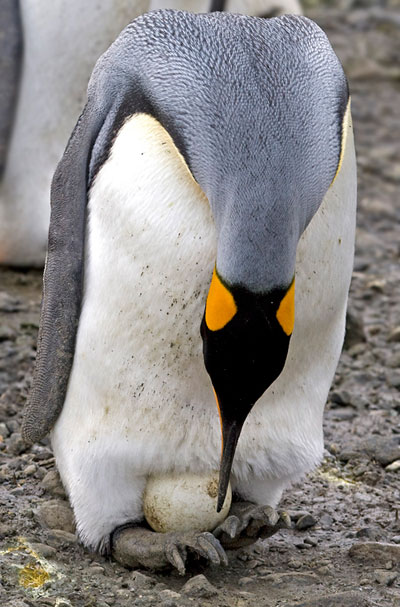
© 2008 Doris Kolber. All rights reserved.
King Penguins lay only one egg. They make no nest and the egg is held on the parent’s feet for the entire incubation of 55 days. Shot taken at St. Andrews Bay on South Georgia Island.
Canon EOS 30D body, Canon 100-400mm f/4.5-5.6 lens at 220mm, f/8 at 1/160sec, ISO 400, hand held
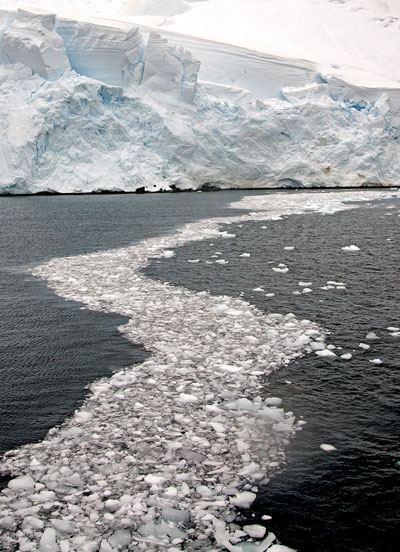
© 2008 Cliff Kolber. All rights reserved.
Lemaire Channel is less than a mile wide and is barely navigable, yet has some of the most incredible scenery along the Antarctic Peninsula. I noticed this “pathway of ice” as we were approaching and shot it while passing by.
Nikon D300, Nikon 24-120mm f/3.5-5.6 lens at 24 mm, f/8 at 1/250 sec, ISO 400, hand held from deck of ship
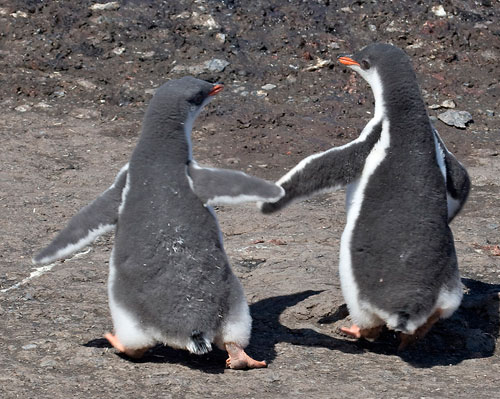
© 2008 Cliff Kolber. All rights reserved.
Doris and I hope you enjoyed a few photos from our gallery of images.
Gentoo Amore. Hannah Point, Antarctica Peninsula
Canon EOS 30D body, Canon 100-400mm f/4.5-5.6 lens at 160mm, f/11 at 1/320sec, ISO 200, hand held
I have a 500mm f/4 lens, but decided to leave it at home. I felt that we would be shooting in rapidly changing situations and close enough to the wildlife for our 400mm zoom lenses. In retrospect I am glad that I didn’t bring the longer lens. The 80-400mm was perfect for this trip.
To store and back up our files, we brought our Sony VAIO laptop computers, along with external pocket size 100GB hard drives. Each of the laptops weighs just over two pounds and they fit easily into our backpacks. For backup purposes, the little bit of time and effort that it takes to transfer files from a computer to an external drive is well worth the effort. We kept the backup drives with us in our backpacks during the day, while the laptops remained back at the ship. It is always a good idea to keep your backup drives in a location away from the computer, in case something unforeseen occurs.
A trip to Antarctica is definitely not for everyone, but if you have a sense of adventure and enjoy nature and the outdoors, this is an expedition not to be missed. Of all the destinations we have visited, Antarctica remains our favorite. We hope you have the opportunity to find out why.
by Cliff Kolber
Photography by Cliff Kolber and Doris Kolber

Wonderful pics really like it ..